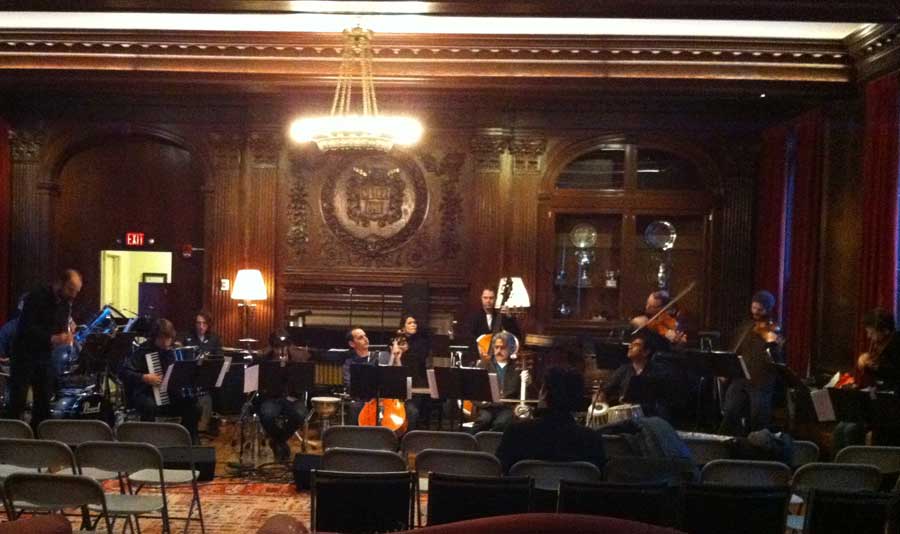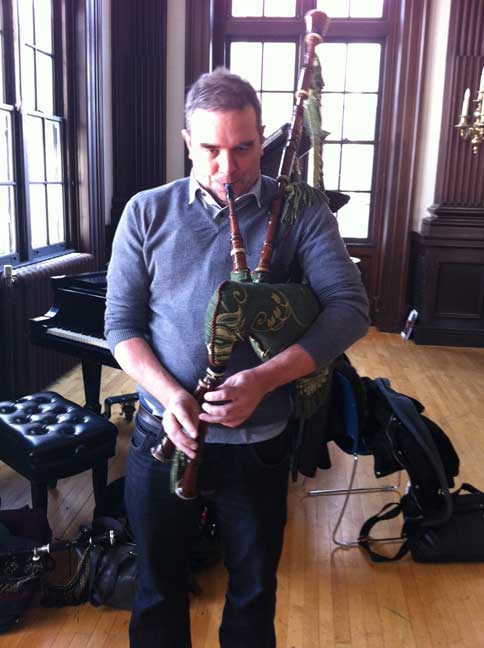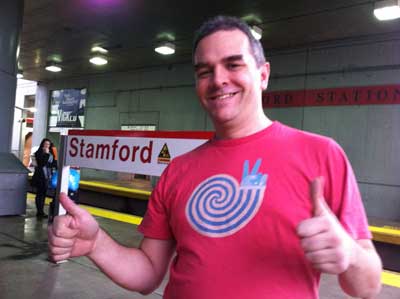Blog
Monthly Archive: January 2012
Silk Road Reflections
Posted on Thursday, January 26, 2012

Silk Road Ensemble, rehearsing Cut the Rug in the beautiful Kirkland House, Junior Common Room, Harvard
I'm just back from an inspiring week in the presence of some of the finest musicians the world has to offer - and that's not just hyperbole, The Silk Road Ensemble really does contain just that. My piece Cut the Rug went down very well, and hopefully will feature in some future performances/tour of the ensemble.
But more interestingly, it was a very thought-provoking week in a variety of ways. It made me think for one about how I, as a composer of mainly notated music, interact with musicians via my score, and the pros and cons of that way of working, versus the aural traditions that exist in most other music cultures. I suppose in a way it reaffirmed my desire to work with musicians that have elements of both worlds - a particular revelation in this respect on this project was Syrian-born clarinettist Kinan Azmeh, who can read the most fiendishly notated music if required (he went to Julliard after all), but can also bring his rich cultural heritage to bear in his use of vibrato and ornamentation for example.

With Kinan Azmeh and Cristina Pato
Working with such a rich array of people from all sorts of cultures around the world inevitably leads you to contemplate ways of living in society and music's place within that. For example, Avi Avital, my hugely talented mandolin-playing friend, is an Israeli and he immediately hit it off with Kinan, a Syrian, and remarked to me that he felt that kinship you feel from someone who shares a similar background - here were two people who have an infinite amount of things in common, whether it be hummus (and how little the US version of hummus resembles the real thing); old TV shows they remember from their childhood in the Middle East; or simply a revulsion at the things that cause their two peoples to seem so far apart on the world stage. And interestingly, as far as the music goes, Kinan's style of playing is often mistaken for klezmer (unless he uses the distinctively arabic scales including quarter-tones), although both myself and Avi could hear something subtle but uniquely different in Kinan's tone.
As to the uses and functions of music in society, well of course most folk music originates in something fundamentally practical - a wedding, a funeral, a dance. I'm inspired by many of these traditions when I write, but of course my music is divorced from those social environments, so what is it's purpose?
I guess part of why I do what I do is to reflect on that very issue - to think about emotional and spiritual questions which are sometimes drowned out by modern life. To throw up these musical landscapes as a sort of hypothesis of things worth exploring.
And yet part of me still is aware of a certain disconnect or hypocracy inherent in what I do - I'm exploring riotous abandon through the use of precision notation; spontaneity through pre-meditation; the life of the body through the use of the mind; the music of 'the village' through something performed in the concert hall.
It's all very complicated, but I do feel that one of the things I want to explore more going forward is something less 'hypothetical' as it were, something that deals with the contemporary world I live in and faces it directly, even if it continues to posit alternatives to it. That probably won't make sense to anyone but me, but useful to try to articulate it.
Just to add to the mix, one of the other composers present for the week was the renowned jazz pianist Vijay Iyer (who wrote a fabulous piece for the group) and during a discussion with students he remarked 'all Classical music - whether it's Western, Iranian, Indian or any other - is basically music for rich people'. That's a very provocative statement, and if it's not true, I certainly haven't found a fully coherent way of refuting it.

Trying to squeeze a note out of the Gaita
Relating somewhat to all the above, I met Cristina Pato, the extraordinary Gaita (Galecian bagpipe) player of the ensemble on the first evening in Harvard. Somehow I immediately knew that she had to be part of my piece, so I got up at 5am the next morning and quickly found two spots for her in my piece. One was at the celebratory/death-defiant ending; the other was at the climax of an aching tutti melody in the third movement.
I've never experienced anything quite like how that moment turned out with Cristina playing - every time she played during rehearsal I would get goose-bumps, and I lost count of the number of people who said they were in tears at that point after the final performance. There is something so intense and raw about the bagpipe sound, it's like a beast, barely under the control of its master, that wails and screams. It's impossible not to be affected by it. The fact that such a moment happened during my piece I took as very little to do with my own creation, and much more to do with the instrument and its amazing 'custodian' - dear Cristina - but it was also one of those miraculous puffs of smoke that sometimes occur during the creative process. A late addition, cobbled together in the early morning before the first rehearsal, becomes the defining moment of the piece. Will someone please just tell me how I can learn from that and recapture it in future?!
Finally, on a lighter note, I was pleased on the train up to Boston to find us passing through my birth-town of Stamford, Connecticut - the first time I had been back since autumn 1970!

Stamford, Conn.
Spring Newsletter
Posted on Thursday, January 5, 2012
To view the online version of my Spring 2012 newsletter please follow this link


